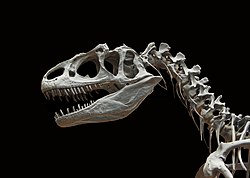{ {{Portal maintenance status|date
IntroductionSelected article on prehistoric North America
Pterosaurs were flying reptiles of the clade or order Pterosauria. They existed from the late Triassic to the end of the Cretaceous Period (228 to 66 million years ago). Pterosaurs are the earliest vertebrates known to have evolved powered flight. Their wings were formed by a membrane of skin, muscle, and other tissues stretching from the ankles to a dramatically lengthened fourth finger. Early species had long, fully toothed jaws and long tails, while later forms had a highly reduced tail, and some lacked teeth. Many sported furry coats made up of hair-like filaments known as pycnofibres, which covered their bodies and parts of their wings. Pterosaurs spanned a wide range of adult sizes, from the very small Nemicolopterus to the largest known flying creatures of all time, including Quetzalcoatlus and Hatzegopteryx.
Pterosaurs are often referred to in the popular media and by the general public as flying dinosaurs, but this is incorrect. However, like the dinosaurs, pterosaurs are more closely related to birds than to any living reptile. Pterosaurs are also incorrectly referred to as pterodactyls, particularly by journalists. "Pterodactyl" refers specifically to members of the genus Pterodactylus, and more broadly to members of the suborder Pterodactyloidea of the pterosaurs. (see more...) Need help?Do you have a question about Abyssal/Prehistory of North America that you can't find the answer to? Consider asking it at the Wikipedia reference desk. Selected article on the prehistory of North America in science, culture and economics
Edward Drinker Cope (July 28, 1840 – April 12, 1897) was an American paleontologist and comparative anatomist, as well as a noted herpetologist and ichthyologist. Cope distinguished himself as a child prodigy, publishing his first scientific paper at the age of nineteen. Cope later married and moved from Philadelphia to Haddonfield, New Jersey, although Cope would maintain a residence and museum in Philadelphia in his later years.
Cope had little formal scientific training, and he eschewed a teaching position for field work. He made regular trips to the American West prospecting in the 1870s and 1880s, often as a member of United States Geological Survey teams. A personal feud between Cope and paleontologist Othniel Charles Marsh led to a period of intense fossil-finding competition now known as the Bone Wars. Cope's financial fortunes soured after failed mining ventures in the 1880s. He experienced a resurgence in his career toward the end of his life before dying in 1897. Cope's scientific pursuits nearly bankrupted him, but his contributions helped to define the field of American paleontology. He was a prodigious writer, with 1,400 papers published over his lifetime, although his rivals would debate the accuracy of his rapidly published works. He discovered, described, and named more than 1,000 vertebrate species including hundreds of fishes and dozens of dinosaurs. His proposals on the origin of mammalian molars and for the gradual enlargement of mammalian species over geologic time ("Cope's Law") are notable among his theoretical contributions. (see more...) Did you know?

Selected image
Quality ContentFeatured prehistory of North America articles - Acrocanthosaurus - Albertosaurus - Allosaurus - Bone Sharps, Cowboys, and Thunder Lizards - Bone Wars -Chicxulub crater - Columbian mammoth - Edward Drinker Cope - Cretaceous–Paleogene extinction event - Daspletosaurus - Deinonychus - Deinosuchus - Dinosaur - Diplodocus - Ediacara biota - Edmontosaurus - Gorgosaurus - Lambeosaurus - Parasaurolophus - Petrified Forest National Park - Stegosaurus - Styracosaurus - Thescelosaurus - Triceratops - Tyrannosaurus - Woolly mammoth Good prehistory of North America articles - ?Oryzomys pliocaenicus - Aetosaur - Archaeomarasmius - Chitinozoan - Cloudinid - Coal ball - Dimetrodon - Stephen Jay Gould - History of paleontology - Kirtlandian - Macabeemyrma - Megalodon - Ornatifilum - Othnielosaurus - Protomycena - Pteranodon - Pterosaur - Saint Croix macaw - Small shelly fauna - Smilodon - Temnospondyli - Tiktaalik - Waptia SubcategoriesThings you can doDesired articles, sorted by how frequently linked to:
Related contentAssociated WikimediaThe following Wikimedia Foundation sister projects provide more on this subject:
|

























